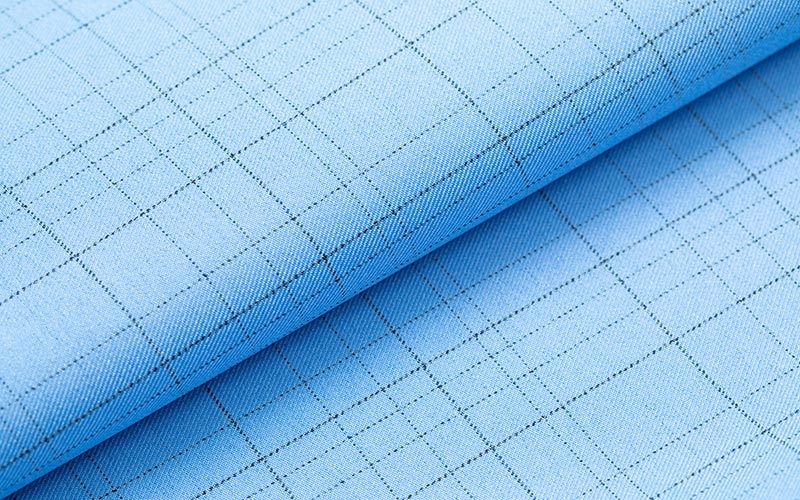
Wie wählt man antistatischen Stoff aus?
2023-11-09 15:11
Antistatisches Gewebe ist ein Textilmaterial, das elektrostatische Aufladung und Entladung verhindert und in der Elektronik, Medizin, Biologie, Optik, Luft- und Raumfahrt, im Militär und anderen Bereichen weit verbreitet ist. Die richtige Auswahl antistatischer Gewebe ist entscheidend für die Sicherheit von Ausrüstung und Personal. Dieser Artikel erklärt, wie Sie ein antistatisches Gewebe auswählen, das Ihren Anforderungen entspricht.
1. Ermitteln Sie die Anwendungsanforderungen
Definieren Sie zunächst Ihre Anwendungsanforderungen. Unterschiedliche Anwendungsumgebungen können unterschiedliche Leistungsstufen antistatischer Gewebe erfordern. Berücksichtigen Sie dabei folgende Faktoren:
Elektrostatischer Widerstandswert: Wählen Sie je nach Anwendungsbedarf das Gewebe mit dem entsprechenden elektrostatischen Widerstandswert aus.
Waschbeständigkeit: Wenn Sie Ihren Stoff häufig waschen müssen, wählen Sie einen antistatischen Stoff mit ausgezeichneter Waschbeständigkeit.
Atmungsaktivität und Komfort: Achten Sie auf den Tragekomfort, insbesondere bei längerem Tragen. Bei einigen Stoffen stehen Atmungsaktivität und Komfort im Vordergrund.
Verschleißfestigkeit und Haltbarkeit: Wenn Ihre Anwendung eineantistatisches GewebeWählen Sie bei guter Verschleißfestigkeit einen Stoff mit den entsprechenden Eigenschaften.
Chemischer Schutz: Wenn die Anwendung antistatische Stoffe mit chemischer Beständigkeit erfordert, berücksichtigen Sie das entsprechende Schutzniveau.
2. Etiketten und Spezifikationen anzeigen
Bei der Auswahl einesantistatisches Gewebe, lesen Sie das Produktetikett und die Spezifikationen sorgfältig durch. Etiketten enthalten oft wichtige Informationen über die Eigenschaften und Merkmale des Stoffes. Achten Sie auf die Angaben auf dem Etikett, z. B. "ESD" oder "Anti-Static", um sicherzustellen, dass der Stoff antistatische Eigenschaften besitzt.



3. Kennen Sie das Material
Antistatische Stoffe bestehen üblicherweise aus Materialien, die mit leitfähigen Fasern gemischt sind. Die Kenntnis der Stoffzusammensetzung ist für die Auswahl des richtigen Stoffes sehr wichtig. Antistatische Stoffe bestehen üblicherweise aus Polyester oder anderen synthetischen Fasern und werden mit leitfähigen Fasern versetzt.
4. Widerstandsmessung
Um die antistatischen Eigenschaften des Gewebes genauer zu bestimmen, können Sie den Widerstandswert mit einem Widerstandsmessgerät messen. Der Widerstandswert antistatischer Gewebe liegt je nach Leistungsstufe üblicherweise zwischen 10^6 und 10^9 Ohm.
5. Branding und Zertifizierung
Achten Sie auf namhafte Marken und entsprechende Prüfzeichen, die die Qualität und Konformität des Produkts bestätigen. Einige Hersteller weisen auf ihren Produkten antistatische Eigenschaften aus oder lassen ihre Produkte durch Zertifizierungsstellen zertifizieren.
6. Optionen anpassen
Erwägen Sie Anpassungsoptionen für Stoffe, einschließlich Sondergrößen, Farben und Stickereien, um den Anforderungen verschiedener Kunden gerecht zu werden.Kundenspezifische ESD-Stoffesind für bestimmte Anwendungsszenarien besser geeignet.
7. Pflege und Wartung
Informieren Sie sich abschließend über die richtige Pflege und Wartung Ihres antistatischen Gewebes, um dessen Lebensdauer zu verlängern. Verschiedene Gewebe haben unterschiedliche Pflegeanforderungen. Befolgen Sie daher unbedingt die Empfehlungen des Herstellers.
Suchen Sie nach zuverlässigen antistatischen Stoffen oder individuellen ESD-Lösungen?
Kontaktieren Sie unser Teamum professionelle Empfehlungen zu erhalten oder Stoffmuster anzufordern, die auf Ihre Anwendungsanforderungen zugeschnitten sind.












